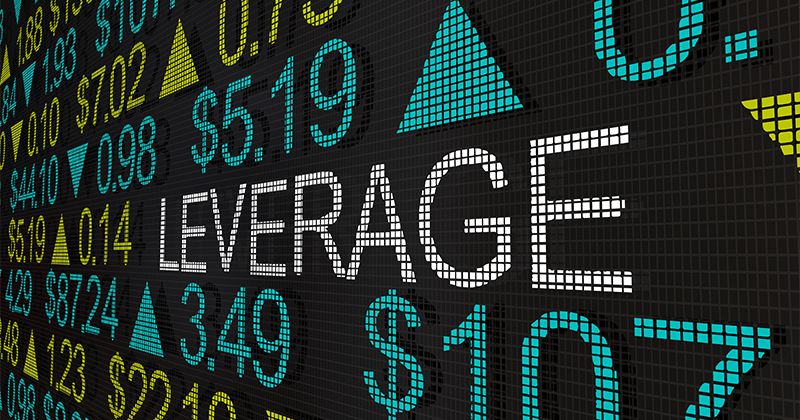The Importance of Effective Leverage in Forex Trading

Leverage brings the excitement factor into forex trading. Traders are able to gain greater exposure to the market than what they could otherwise afford by themselves. However, while leverage increases the potential for gains, losses are amplified too. This is why leverage is often compared to a double-edged sword.
So, choosing an effective leverage ratio is important for long term trading success. When traders undertake leveraged trading, they are required to open a margin account. Traders need to fund this account with an initial margin, a percentage of the full value of the position they intend to open. This amount is used by the broker to place trades in the inter-bank market and to manage all leveraged positions in the trader’s account. If losses erode the margin levels below a prescribed limit, the broker issues a margin call so that the trader can deposit the required amount for leveraged positions to be maintained.
If a trader receives margin calls frequently, it can be a huge hindrance to their long term trading career. After all, once traders are able to return what they have borrowed, they should have some money left over to invest in future positions. That is the whole point of trading on leverage.
The Concept of Effective Leverage
Effective leverage can be defined as the leverage amount that a margin account is actually using to control the total amount of current net positions outstanding on the trader’s account. It is the reduced ratio of the total outstanding net positions to total margin on deposit. Sometimes this is also known as “available leverage.”
Here, the concept of maximum leverage also needs to be understood. The full amount of leverage available to a trader from the broker is the maximum leverage. Most brokers allow a substantial amount of leverage. Traders use a portion of the deposited margin to control one or more larger trading positions, increasing the potential for gains and risks on the account.
The value of effective leverage can differ substantially from maximum leverage. Let’s see this through an example.
Consider a trader who holds a standard lot ($100,000) of USD/JPY outstanding and the size of their account is $10,000. This $10,000 is the deposit margin. Here, the effective leverage can be calculated by dividing $100,000 by $10,000 and expressing the result as a ratio. The current effective leverage will be 10:1. Every $10 of the trading position is being effectively controlled by $1 in the account.
The effective leverage will magnify both gains and losses 10 times, as compared to a position that does not use leverage. In case a cross currency position is held, the total base currency notional amount will have to be converted into the accounting currency. So, suppose a trader has a long USD/JPY position, they cannot take a short USD/AUD position against that to make a long AUD/JPY position.
These crosses will be considered as two separate transactions versus the US Dollar by most brokers. In that case, the absolute notional value of their positions will be used for leverage computation. Both positions will be considered to calculate the notional value outstanding in effective leverage calculations.
This is different from the maximum leverage offered by the broker, which might be 100:1 or 200:1.
Importance of Effective Leverage
Traders often want to ascertain the effective leverage of their trading account, along with the amount of leverage they still have available to be used in times of a potential trading opportunity.
This can help manage overall trading risk and in staying below the maximum leverage limits imposed by a broker. It also helps to avoid margin calls or position closeouts, which brokers have to resort to in case of insufficient margin to support outstanding transactions.
The idea of optimising the use of leverage is based on the goal of maximising growth of trading accounts, while not risking the total depletion of forex trading funds.
Keeping an eye on effective leverage helps keep levels of trading risks visible and tolerable. Money management and risk management have been proven to be linked to each other. The Kelly criterion is an important example of this.
Kelly’s leverage optimisation concept is based on the formula: L = (E-R)/ V
Here, L represents the optimal effective leverage that traders can aim for in their accounts. The term (E-R) shows the excess return of the trading strategy, where E is the rate of return and R is the risk-free interest rate. The term V is the expected statistical variance of the strategy’s excess return.
So, suppose the expected annual rate of return is 20% or 0.20, the risk-free rate of interest is 2% or 0.02, and the variance of the strategy’s excess return is 0.01, then the value of L would be:
L = (0.20-0.02)/ 0.01 = 18
This means that the trader should aim for an effective leverage ratio of 18:1. However, the Kelly criterion was designed for extremely high risk-taking traders, whereas most traders might feel comfortable with an optimal effective leverage of up to 10:1.
Picking the Right Leverage Ratio
Forex traders need to adopt a maximum leverage depending on their risk-reward profile and trading goals. It also depends on the trader’s experience. It is best for beginners to start low. Three main factors need to be considered:
- Starting with low levels of leverage.
- Never risking more than 1% or 2% of the trading capital in each position.
- Using risk management tools like stop-loss, take-profit and trailing stops to limit downside risk.
Trading styles can have a say too. For instance, scalpers and breakout traders tend to use higher leverage ratios, since they get in and out of trades quickly, multiple times a day. On the other hand, position traders might prefer low leverage.
It is good to start with a forex demo account to test the trading strategy and leverage mixes, without risking any money. Lastly, different regulatory bodies have imposed leverage limits on their brokers, to protect investor interests. It’s wise to be associated with a regulated broker to avoid falling into the trap of crazy high leverage limits.




